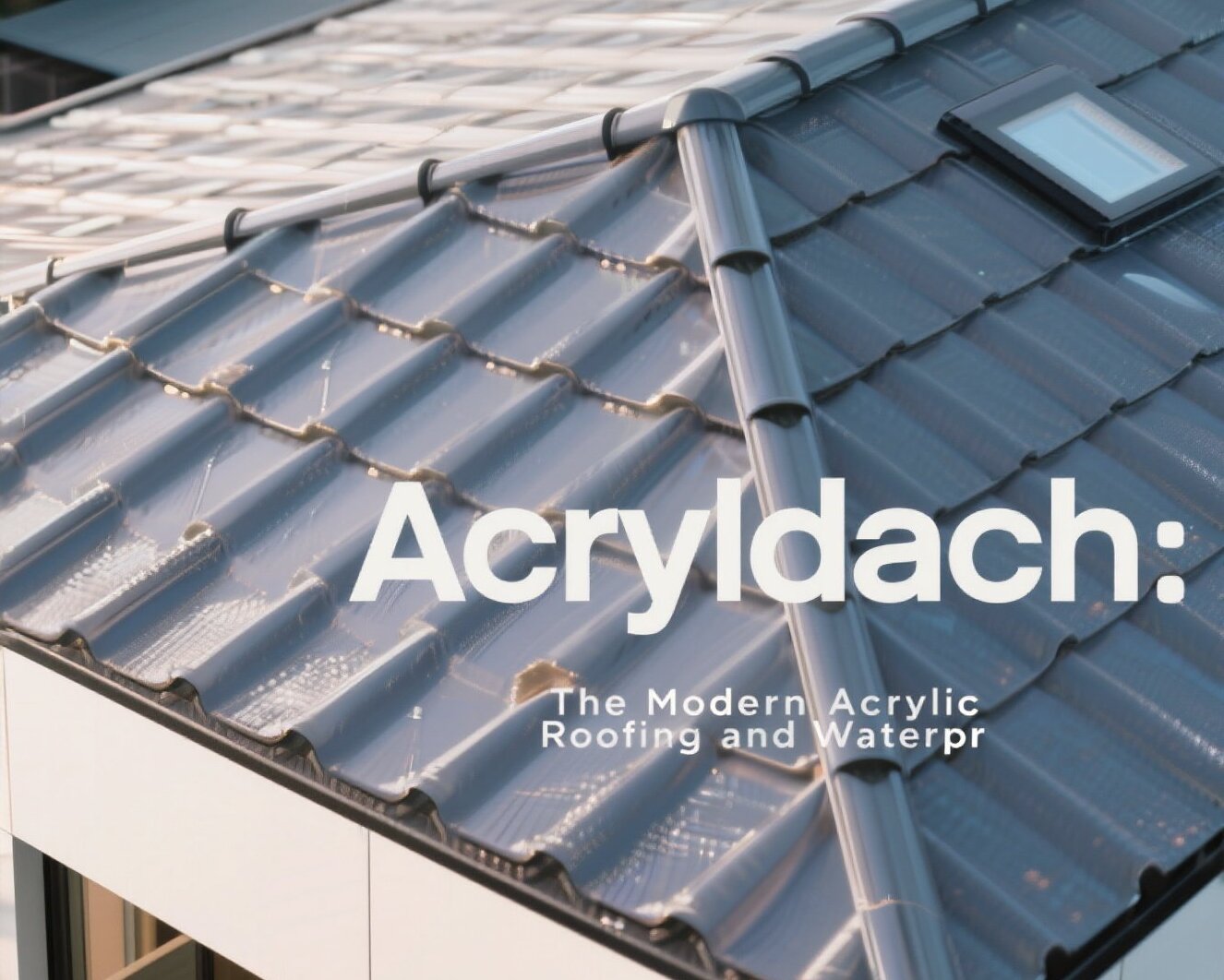1. Introduction to Acryldach
Roofing technology has undergone major transformations in recent decades, with a shift from heavy, rigid, and maintenance-intensive systems to lightweight, durable, and energy-efficient solutions. One of the standout innovations in this evolution is Acryldach, a modern roofing and waterproofing option that combines performance, sustainability, and cost-effectiveness.
The term Acryldach is derived from two words—“acryl,” meaning acrylic, and “dach,” the German word for roof. As the name suggests, it encompasses roofing systems and coatings developed from acrylic-based materials. What makes Acryldach unique is its dual application: it can refer to liquid-applied acrylic coatings used for waterproofing or acrylic panels/sheets that act as lightweight roofing solutions.
This versatility is one reason behind its rapid adoption across industries. For homeowners, Acryldach extends the life of existing roofs while reducing energy bills. For commercial properties, it provides a cost-effective, low-maintenance roofing option that keeps buildings cooler. And for industrial facilities, its resistance to pollutants and harsh weather makes it a long-term investment.
As sustainability and durability take center stage in construction, Acryldach is quickly emerging as a modern roofing choice that balances strength, aesthetics, and efficiency, making it suitable for both new builds and renovations.
2. What Is Acryldach?
At its core, Acryldach refers to roofing materials and coatings created using acrylic polymers, particularly polymethyl methacrylate (PMMA), a synthetic resin known for its strength, clarity, and UV resistance. This composition makes Acryldach highly durable while still lightweight, setting it apart from traditional roofing materials like asphalt shingles, clay tiles, or heavy metal sheets.
There are two main forms of Acryldach in the market:
- Liquid-applied coatings – These are rolled or sprayed onto roofs to form a seamless, elastic waterproofing membrane. Unlike older waterproofing methods that required heating or adhesives, liquid Acryldach cures naturally and adheres strongly to concrete, bitumen, or metal surfaces.
- Acrylic panels or sheets – These rigid materials are used for roofing structures such as greenhouses, patios, carports, and industrial skylights. They combine transparency and strength, allowing natural light to pass through while providing weather resistance.
Compared to traditional roofing, Acryldach offers clear advantages. It is more flexible than asphalt, lighter than clay tiles, and more energy-efficient than metal sheets. While traditional systems often crack, corrode, or require frequent maintenance, Acryldach maintains its integrity under extreme weather, making it a forward-looking alternative in roofing technology.
3. Key Benefits of Using Acryldach
3.1 Exceptional Waterproofing
One of the biggest advantages of liquid-applied Acryldach is its outstanding waterproofing ability. When applied, the liquid coating cures into a seamless, joint-free surface that eliminates weak points where leaks typically occur. This makes it particularly effective for flat roofs or areas with low slopes, where water pooling is a common issue.
Unlike sheet-based waterproofing membranes, which rely on seams or overlaps, Acryldach’s continuous surface ensures long-term leak prevention. This reduces the risk of costly water damage inside buildings and makes it ideal for regions with heavy rainfall or unpredictable climates.
3.2 Resistance to UV and Weather Damage
Roofs are constantly exposed to harsh elements—scorching sun, freezing winters, heavy rains, and strong winds. Acryldach is engineered to resist UV degradation, preventing it from cracking, yellowing, or peeling over time. This stability ensures that the material maintains both its structural strength and aesthetic appeal.
Whether in tropical climates with intense sunlight or snow-prone regions, Acryldach holds up better than asphalt or metal roofs, which often deteriorate faster under such conditions.
3.3 Cost-Effective and Energy Efficient
Although the upfront cost of Acryldach may be higher than asphalt shingles, its energy-saving benefits and long lifespan make it more economical in the long run. Acrylic coatings and panels reflect sunlight, helping regulate indoor temperatures and reducing the strain on air conditioning systems.
Studies have shown that buildings with reflective acrylic coatings can lower cooling costs by 10–20% annually, a significant saving for large commercial and industrial spaces. Additionally, with lifespans of 15–20 years, Acryldach reduces the need for frequent replacements, lowering long-term costs.
3.4 Aesthetic and Design Flexibility
Beyond function, Acryldach also delivers on visual appeal. Acrylic panels can be manufactured in clear, tinted, or frosted finishes, offering architects and homeowners flexibility in design. They allow natural light to enter spaces like patios, skylights, or greenhouses without compromising durability.
This makes Acryldach a favored material for modern architecture, where both aesthetics and performance matter.
4. Common Applications of Acryldach
4.1 Residential Roofs
For homeowners, Acryldach offers a versatile solution for flat roofs, skylights, patios, and carports. Its waterproofing coatings can be applied directly over existing roofs, extending their life without the need for a full replacement. Its reflective properties also contribute to cooler interiors and lower utility bills.
4.2 Commercial Properties
In shopping malls, office buildings, and retail centers, Acryldach is valued for its low maintenance and energy efficiency. By reducing HVAC costs and offering long-term protection against leaks, it helps businesses save money and ensures uninterrupted operations.
4.3 Industrial Use
Factories and warehouses often face challenges such as chemical exposure, heavy foot traffic, and harsh weather. Acryldach’s resistance to industrial pollutants and structural stress makes it a reliable choice for these environments. It can even withstand occasional contact with industrial chemicals, further enhancing its appeal.
4.4 Public Infrastructure
From bus stops to stadium roofs and walkways, Acryldach’s lightweight yet durable nature makes it an excellent material for public infrastructure. Its transparency allows natural light into public spaces, reducing reliance on artificial lighting.
5. The Installation Process of Acryldach
5.1 Site Inspection and Surface Preparation
Proper installation begins with inspection and cleaning. Roofs must be cleared of dirt, debris, and loose materials. Any cracks or structural damages are repaired to ensure a stable foundation. For panel systems, a strong framework of metal or treated wood is set up.
5.2 Primer and Sealer (for liquid systems)
For porous surfaces like concrete, applying a primer ensures better adhesion of the coating. This step prevents peeling or blistering later and enhances the lifespan of the waterproofing system.
5.3 Coating Application
Liquid Acryldach is applied in multiple layers, either by rolling or spraying. Each coat is allowed to cure before applying the next, ensuring maximum durability and water resistance. The thickness of the coating can be customized depending on exposure to weather conditions.
5.4 Panel Cutting, Sealing, and Placement
For panel-based installations, acrylic sheets are cut to size and carefully handled to avoid scratches. They are fastened with corrosion-resistant screws and sealed at the joints to prevent leaks. Edge trims and protective finishes may also be added for aesthetics.
6. Maintenance and Lifespan of Acryldach Roofs
Acryldach systems are designed for long life with minimal upkeep, typically lasting 15–20 years or more. Maintenance is straightforward:
- Inspect annually for cracks, wear, or debris.
- Clean surfaces with mild soap and water to prevent dirt buildup.
- Recoat liquid systems every 5–10 years depending on wear.
Compared to traditional roofs that require frequent patching, tile replacement, or rust treatment, Acryldach offers a “low-maintenance, high-performance” solution that appeals to both homeowners and property managers.
7. Advantages Over Traditional Roofing Systems
When compared directly, Acryldach consistently outperforms older materials:
- Weight: Lighter than tiles or metal, reducing structural load.
- Transparency: Provides natural light where needed (skylights, greenhouses).
- UV Resistance: Superior protection against sun damage.
- Installation Speed: Faster and less labor-intensive.
- Maintenance: Lower costs and less frequent repairs.
These advantages make it especially valuable for modern, eco-conscious construction.
8. Limitations of Acryldach
Despite its benefits, Acryldach isn’t without challenges. High-quality acrylic materials cost more upfront than asphalt or corrugated metal. Acrylic panels are also prone to scratches, requiring careful handling during installation and maintenance.
Additionally, acrylic materials expand and contract with temperature changes, meaning installations must account for thermal expansion gaps to prevent warping or cracks.
9. Eco-Friendliness and Sustainability of Acryldach
Sustainability is a major reason behind Acryldach’s rising popularity. Its reflective coatings reduce energy usage, while transparent panels allow natural lighting, cutting down reliance on electricity.
Furthermore, acrylic materials are recyclable, making them an eco-friendly alternative to non-recyclable roofing waste. With longer lifespans than traditional roofs, Acryldach also helps reduce construction-related waste, supporting a greener building industry.
10. How to Choose the Right Acryldach System
When selecting an Acryldach system, consider:
- Panel Thickness – Thicker panels provide better insulation and durability.
- Transparency Levels – Choose between clear, tinted, or frosted depending on needs.
- Coating Enhancements – Anti-scratch or anti-fog coatings add extra performance.
- Warranties – Look for manufacturer guarantees against UV damage and defects.
Careful evaluation ensures you invest in a system that balances cost, performance, and aesthetics.
11. The Future of Acryldach in Modern Architecture
With construction trends shifting towards sustainability, energy efficiency, and smart homes, Acryldach is expected to play a central role. Future innovations may lead to lighter, stronger, and multi-functional acrylic systems, potentially integrated with solar panels or self-cleaning coatings.
Its ability to combine durability, natural lighting, and energy savings positions Acryldach as a future-proof roofing solution for eco-conscious architecture.
12. Final Thoughts
Acryldach is more than just another roofing option—it’s a comprehensive solution that blends waterproofing, durability, design flexibility, and energy efficiency. Whether applied as a liquid coating or installed as acrylic panels, it provides long-term protection and value.
For homeowners, it means comfort and savings. or businesses, it ensures reliability and lower operational costs. For industries, it provides strength against harsh conditions. In short, Acryldach is reshaping the future of roofing, offering a smart investment that balances performance, sustainability, and aesthetics.










